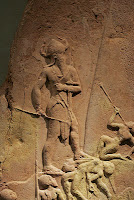The way to the Underworld..blood of the lamb.
... it is the offering pit that I dislike the most.
Hard times create hard hearts.
I don't mean the pit inside rectangular buildings (see previous post) to contain the slaughtered cattle. I'm thinking of the shafts...with the (in one case at least) four meter pole erected on the shaft floor and the remains of flesh around it.
I'm not saying that the Wilsford shaft is like that; it was created in happier times and dug out with antler picks in 1700 BC by people now called by contemporary archaeologists, Deveral-Rimbury. It is six feet wide and reached a hundred feet into the earth. Then the pit reached water, so could not be dug any deeper.
I know what you are thinking...but it was never used as a well, the presence of water may instead have made it a more suitable receptacle for sacrifices.
At the bottom of the Wilsford shaft there were bone pins and amber beads, pots and an ox skull -indicating to me anyway- that this shaft was used as a communication with the Underworld. Right at the bottom, propped against the side of the shaft archaeologists found an oak post.
Offering pits seem to have been dug in the Neolithic too, but as the Bronze Age transformed itself into the Iron Age the contents of the pits become more sinister...
By the time we get to the Iron Age the pits are being offered human flesh:
But, back to the pits and their meaning; above and below, heaven and earth form the universe.
In Greek myth and ritual the Chthonic and Olympian belong together. It is fascinating to consider that the Greek gods seem to have mortal counterparts who they will kill: Artemis demands the sacrifice of Iphigenia, Apollo kills Hyakinthos.
Sacrificial pits in ancient Greek times were the Bothros or Megaron, the Megaron in particular is linked to Demeter and Kore, during the Thesmophoria festival women were said to throw piglets into the 'chasms of Demeter and Kore' recreating the scene of Kore's abduction -when the ground opened to allow Hades through and the pig-Herder lost his pigs.
But said by whom is another matter.
Rome had at least two lapis manalis (stone covering a pit allowing access to the souls of deceased loved ones): one named by Festus the ostium Orci (the gate of Orcus- a god of the underworld, punisher of broken oaths, portrayed in paintings in Etruscan tombs as a hairy, bearded giant. The name probably comes from Greek: Horkos described by Hesiod in his Theogeny, a child of the Erinyes who personifies the curse that will be inflicted on any person who swears a false oath) and another lapis used to call down rain...
More commonly a lapis manalis was dug as part of the foundations of a new town as a way to offer the 'lords of the soil' libation. It is possible that the gladiatorial games were a continuation or a civilising of this concept of offering blood to ghosts.
The closest thing I've experienced to any of this was the recent outbreak of foot and mouth in sheep and cattle which resulted in an economic and political decision, rather than a scientific one, to kill possibly as many as 10 million animals at a cost to the British tax payer of £20 billion...[LINK]
The whole thing was unbelievable really, a ritual purification of our food because the government must be seen to be doing something. Sensible solutions such as vaccination are out because vaccination would produce antibodies in animals, and the test for the disease is the presence of antibodies...there isn't a system set up that allows vaccination certification to prove 'purity'.
And virus' mutate rapidly, it is hard to create an antibody for all types- but not impossible.
Taking care of sick animals only happens if the causative agent is a bacteria in which case liberal doses of antibiotics are administered, taking care doesn't happen in industrial style farming.
We no longer have any culturally acceptable need of making offerings to the ghosts underground, yet this mass killing echos rituals of the past in a truly disturbing way.
Hard times create hard hearts.
I don't mean the pit inside rectangular buildings (see previous post) to contain the slaughtered cattle. I'm thinking of the shafts...with the (in one case at least) four meter pole erected on the shaft floor and the remains of flesh around it.
I'm not saying that the Wilsford shaft is like that; it was created in happier times and dug out with antler picks in 1700 BC by people now called by contemporary archaeologists, Deveral-Rimbury. It is six feet wide and reached a hundred feet into the earth. Then the pit reached water, so could not be dug any deeper.
I know what you are thinking...but it was never used as a well, the presence of water may instead have made it a more suitable receptacle for sacrifices.
At the bottom of the Wilsford shaft there were bone pins and amber beads, pots and an ox skull -indicating to me anyway- that this shaft was used as a communication with the Underworld. Right at the bottom, propped against the side of the shaft archaeologists found an oak post.
Offering pits seem to have been dug in the Neolithic too, but as the Bronze Age transformed itself into the Iron Age the contents of the pits become more sinister...
By the time we get to the Iron Age the pits are being offered human flesh:
A late Iron age shaft in Holzhausen in Baviaria with a post at the bottom was presumably used for impaling a human victim; the pole when analysed had traces of human flesh and blood. In East Yorkshire, at Garton Slack a young man and a woman of about thirty were found huddled together in a shaft, a wooden stake between them pinning their arms together; the woman was apparently pregnant, since a fetal skeleton was found beneath her pelvis. Presumably the two adults were ritually killed for punitive purposes. There have also been several instances of foundation burials, often of children, which may or may not have been sacrifices (Green 1992, 183-84).Holzhausen is a Late Iron Age "ditch-and-berm" constructions known as a Viereckschanzen. It isn't a common term in the UK, such a site would probably be labelled on a map as a Pre-Roman sacred site, or a Romano-Celtic temple. Both Gourney-sur-Aronde and Ribemont-sur-Ancre are Viereckschanzen, but true examples are hard to find in Britain.
But, back to the pits and their meaning; above and below, heaven and earth form the universe.
In Greek myth and ritual the Chthonic and Olympian belong together. It is fascinating to consider that the Greek gods seem to have mortal counterparts who they will kill: Artemis demands the sacrifice of Iphigenia, Apollo kills Hyakinthos.
Sacrificial pits in ancient Greek times were the Bothros or Megaron, the Megaron in particular is linked to Demeter and Kore, during the Thesmophoria festival women were said to throw piglets into the 'chasms of Demeter and Kore' recreating the scene of Kore's abduction -when the ground opened to allow Hades through and the pig-Herder lost his pigs.
But said by whom is another matter.
Rome had at least two lapis manalis (stone covering a pit allowing access to the souls of deceased loved ones): one named by Festus the ostium Orci (the gate of Orcus- a god of the underworld, punisher of broken oaths, portrayed in paintings in Etruscan tombs as a hairy, bearded giant. The name probably comes from Greek: Horkos described by Hesiod in his Theogeny, a child of the Erinyes who personifies the curse that will be inflicted on any person who swears a false oath) and another lapis used to call down rain...
More commonly a lapis manalis was dug as part of the foundations of a new town as a way to offer the 'lords of the soil' libation. It is possible that the gladiatorial games were a continuation or a civilising of this concept of offering blood to ghosts.
The closest thing I've experienced to any of this was the recent outbreak of foot and mouth in sheep and cattle which resulted in an economic and political decision, rather than a scientific one, to kill possibly as many as 10 million animals at a cost to the British tax payer of £20 billion...[LINK]
The whole thing was unbelievable really, a ritual purification of our food because the government must be seen to be doing something. Sensible solutions such as vaccination are out because vaccination would produce antibodies in animals, and the test for the disease is the presence of antibodies...there isn't a system set up that allows vaccination certification to prove 'purity'.
And virus' mutate rapidly, it is hard to create an antibody for all types- but not impossible.
Taking care of sick animals only happens if the causative agent is a bacteria in which case liberal doses of antibiotics are administered, taking care doesn't happen in industrial style farming.
We no longer have any culturally acceptable need of making offerings to the ghosts underground, yet this mass killing echos rituals of the past in a truly disturbing way.

